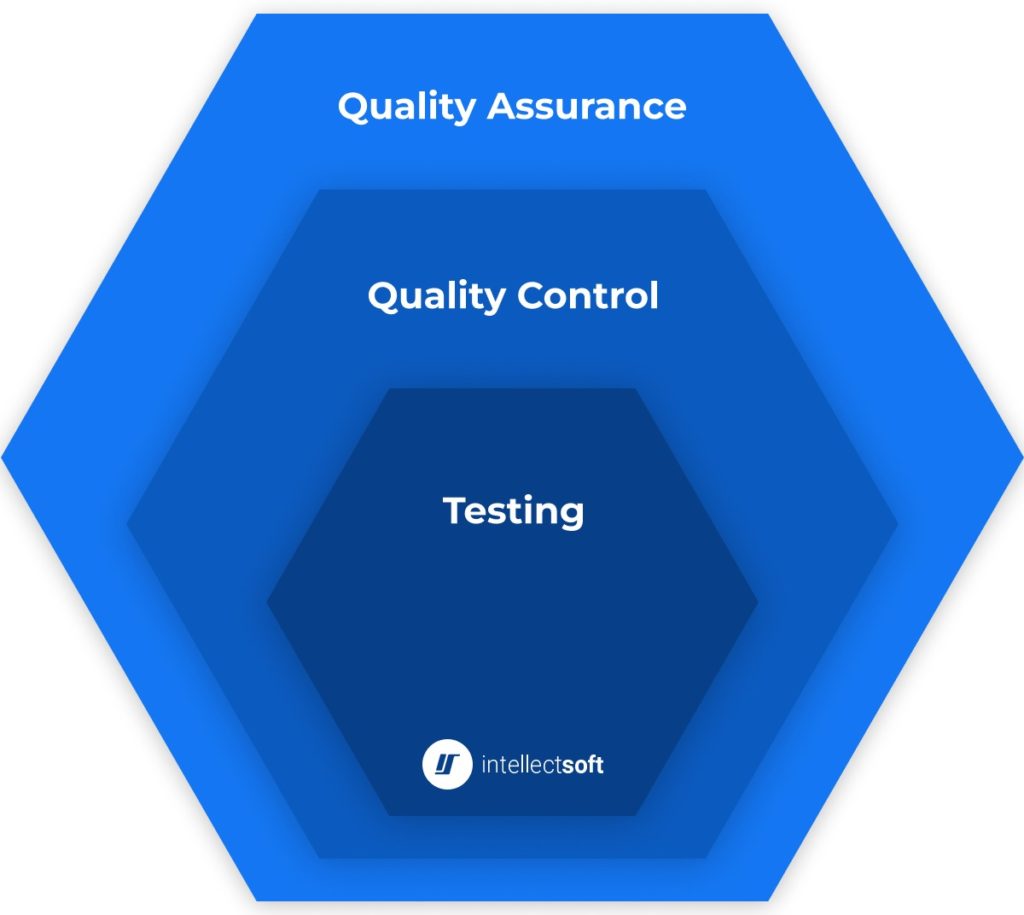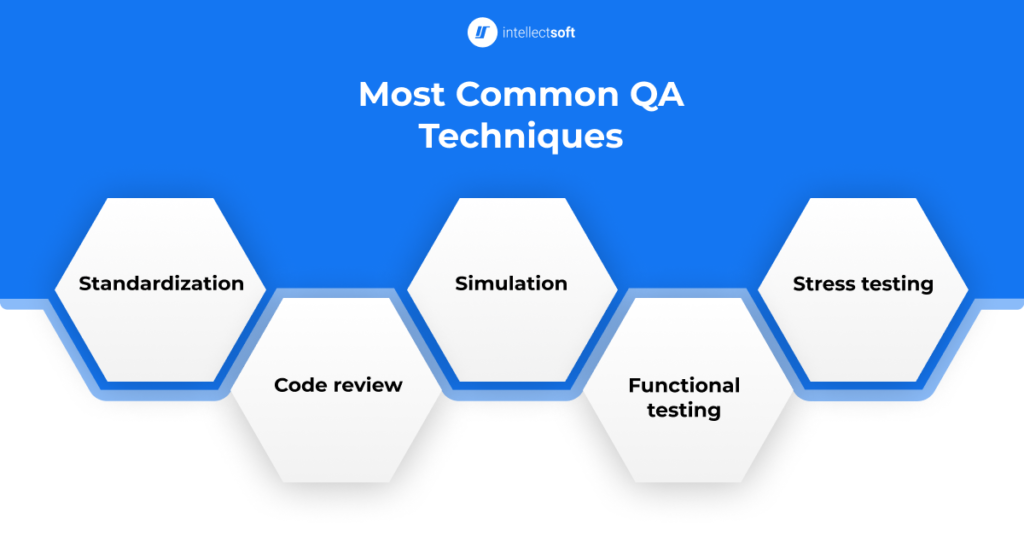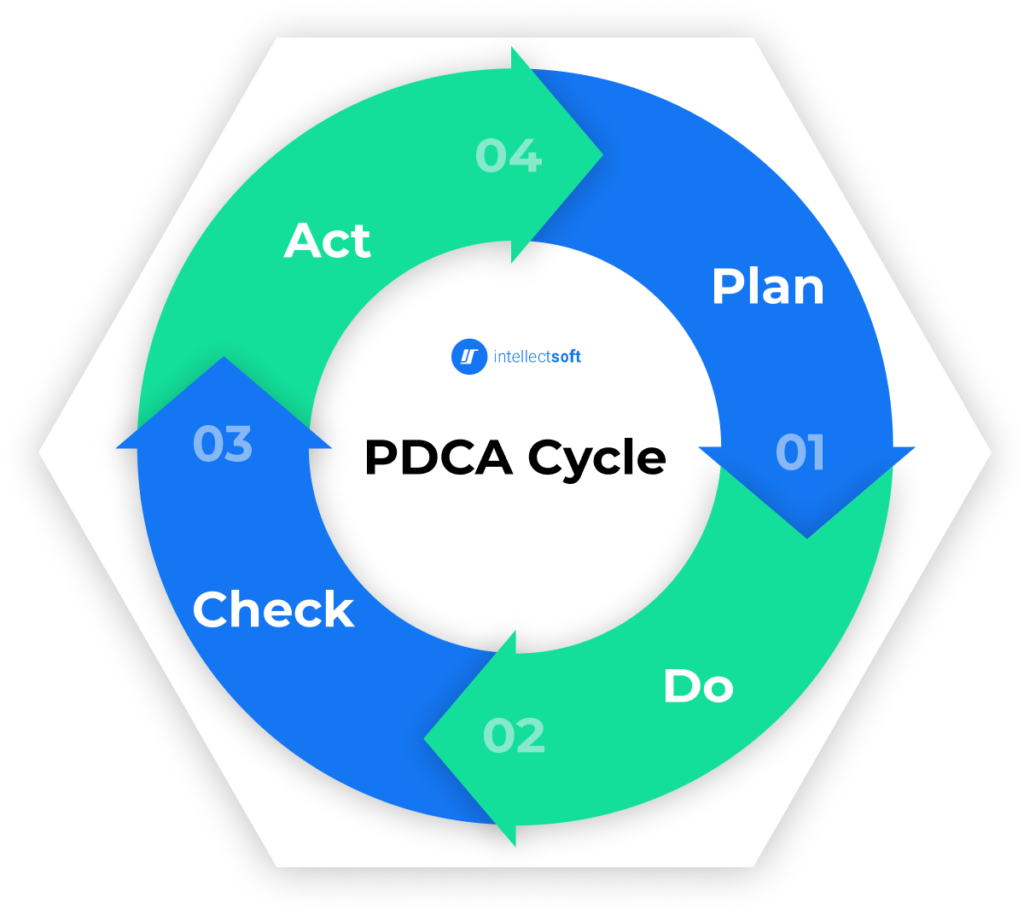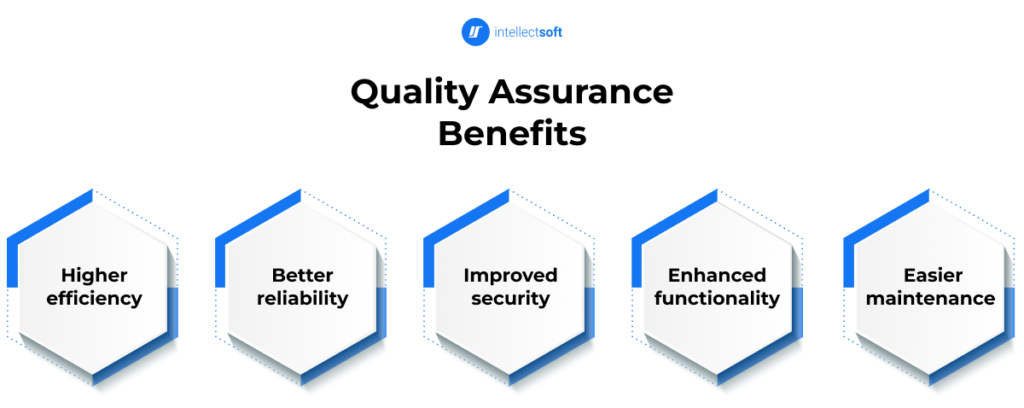Regardless of the scale, software development always involves an investment of resources. If the quality of the final product is failing, the resources will be wasted. The funds will be gone forever and the investors will lose money, time, as well as potential profits and sometimes even damage their reputation. That’s why quality assurance is perhaps the most prioritized process in software development.
What is Quality Assurance in Software Development?
Quality assurance, or simply QA, is a complex process that covers several stages of ensuring the required standards of quality. In software development, this process involves a wide range of measures and starts long before writing the first lines of code. It includes proper planning of the development process, as well as evaluating, controlling, and testing the quality of a product throughout its creation. QA also covers optimization and reporting routines which will be described later in this article, along with other components of quality assurance.

The Role of Quality Assurance in Software Development
One can safely say that quality assurance is of vital importance in software development. It is true not only because of financial reasons. Though business priorities always revolve around money, QA also protects reputation. A software product with subpar quality can lead not only to financial losses but also to the loss of trust of customers and business partners. This could be a fatal blow to the startup or a company.
As a result, entrepreneurs highly appreciate the importance of QA, particularly in the field of IT. They understand that time and money spent on ensuring the quality of a software product are fully justified. It is highly important to find and correct errors in software as early as possible. The longer those flaws remain undetected and unresolved, the bigger risk they represent and the more difficult it is to fix them.
The role of QA in software development is much larger than just testing and finding bugs. It goes beyond quality control to the field of methodology. In particular, quality assurance deals with means and standards to organize the development process in such a way that prevents the appearance of errors. In other words, QA specialists research how to satisfy the client’s requirements while eliminating potential vulnerabilities and defects. This analysis at an early stage of development prevents a lot of trouble that may arise at subsequent stages.
The Quality Assurance Process in Software Development
Considering its major importance, quality assurance is not performed chaotically but as a strictly specified process. Some people, who are familiar with various models of the SDLC, believe that QA is just a step generally called “testing” in this process. However, this common misconception is far from the truth.
Difference between Quality Assurance and Quality Control
Quality assurance extends throughout the whole software development process. Let’s take, for example, a conventional “waterfall” model of the software development life cycle. It has five phases or stages: analysis, design, coding, testing, and operations. The purpose of QA is to make sure that all the processes in those phases are performed according to the respective quality standards.
Product testing is the task of Quality Control (QC), which in its turn is a component of an extensive Quality Assurance (QA) routine. It is a crucial stage before the deployment or release of a software product. However, it is necessary to distinguish QA and QC.
Quality Control focuses on ensuring the quality of a product by performing tests, finding flaws, and correcting them. QC also determines if the product meets the client’s requirements. Testing, bug fixing, optimization, and other aspects of Quality Control must be completed before the product or feature moves to the deployment stage of the development process.
Quality Assurance oversees the processes during software development to prevent errors by abiding standards, implementing efficiency metrics, performing verifications, etc. So, the main difference between Quality Assurance and Quality Control is that QA is more extensive and process-oriented, while QC is more focused and product-oriented.
QA Standards for Software Development
To make quality requirements more uniform, engineers have designed specific strict rules and practices to be applied in various industries. The International Standards Organization has a family of standards for quality management labeled ISO 9000. Within this family, the document ISO/IEC/IEEE 90003:2018 sets specific guidelines for implementing the standard ISO 9001 for a quality management system in the field of software engineering.
Most Common Techniques in QA
Quality Assurance specialists have several methods and established processes at their disposal. As an example, five of the most widely used techniques in the context of software development are briefly described below.

- Standardization. This technique is used to determine whether the product, feature, or process satisfies the applied standard. In this context, the standard in question is usually ISO 9001.
- Code review. This activity represents the “classic testing” aimed at finding bugs in the code and is most commonly associated with QA. This is one of the crucial steps to prevent flaws from becoming bigger problems at subsequent stages of the software development life cycle.
- Simulation. This technique allows developers to observe how the simulated program would behave under normal working conditions. This is done when the software build is not ready physically, so a virtual model is created.
- Functional testing. Specialists use this technique to see what the current build of the software can do in the context of its intended functions.
- Stress testing. As the name implies, stress testing is intended to show how the software can handle situations that exceed normal working parameters. For example, one of the most common scenarios is the performance of an app when too many users are trying to access it at the same time.
It should be noted that this list is merely illustrative and not exhaustive. Many other techniques can be used for QA purposes, including auditing, static testing, design analysis, etc.
PDCA Cycle in Software Development
One of the quality assurance methods in software development is the PDCA cycle. It is used as a repetitive process of making changes for the improvement and optimization of features and products. The cycle consists of four steps that are repeated until all flaws are corrected. The names of the steps make up the abbreviation “PDCA”:

- Plan. In this step, the specialists pinpoint the problem that must be corrected. If several problems are discovered, then priorities must be established. Each problem or flaw is considered an opportunity to make an improvement. Then specialists set the objectives and design the optimal course of action. They define the schedule with deadlines and assign executives to carry out every set task.
- Do. The plan is set to action. The assigned specialists with the required skills perform every objective according to the plan. This process is monitored, and data is gathered to be analyzed later.
- Check. Now, the actions performed in the second step are analyzed, and conclusions regarding the results are made. If those actions were not enough to achieve improvement, further adjustments are planned.
- Act. The final step is taking an action based on the analysis conducted in the third step and all the data collected during the previous three steps. If the problem is solved, the measures that were taken to fix it are recorded as a solution for further reference. This way, if a similar problem occurs in the future, there will be a proven detailed way to fix it. If the problem still persists, the initial plan and objectives are adjusted based on obtained data, and the cycle repeats until a proper solution is found.
In software development, the PDCA cycle not only leads to the improvement of the product but also enhances the existing methods of Quality Assurance and Control. The documentation of problems and processes helps in finding new solutions and preserving effective ways of finding and preventing flaws. It also helps in teaching specialists about newly invented tools and practices of QA.
Benefits of Quality Assurance in Software Development
Since QA is focused on improving the quality of a software product, it has an immense potential of providing various advantages both for product owners as well as for users. Let’s review the benefits that arise from better quality.

- Higher efficiency. A top-quality software product runs much better than one with subpar quality. This means that the software performs its intended functions faster, which saves users’ time and improves productivity.
- Better reliability. QA ensures that the final product is safe to use and can handle prolonged sessions of uninterrupted use as well as stress conditions. For example, a software product will not crash under heavy loads, which prevents data loss or other harmful aftermaths.
- Improved security. Quality Assurance is essential for providing the best possible protection of confidential data, which is one of the main requirements across all industries. This is especially true for such areas as healthcare, retail, and other businesses that deal with personal information, payments, etc. For example, Quality Assurance is responsible for making a healthcare software application HIPAA-compliant. QA ensures that storages that contain sensitive data are protected from break-ins and the related infrastructure is secure against malicious attacks.
- Enhanced functionality. As a result of QA processes, the final software product should have all the intended functions as set in the specifications. Quality Assurance oversees the proper implementation of the functions and the correct integration of the software into its working environment, infrastructure, networks, etc.
- Easier maintenance. QA makes sure that the software product can be easily maintained and adjusted according to changed conditions, if necessary. Even when a client requires a limited set of software features, Quality Assurance specialists should enable the possibility of adding more features in the future. According to QA practices, a software product must be allowed to evolve and improve.
All the listed advantages ultimately lead to one: benefit your business. A quality software product will earn more money for its owners. It will be more effective and easier to use, which will draw more loyal clients. Moreover, a software product created according to quality standards will promote its owners’ business, earning respect and building a good reputation.
Conclusion
As you can see, Quality Assurance is a crucial part of the software development process. Due to its extreme importance, QA must be performed and managed by highly skilled specialists. Moreover, they should be organized into established teams with effective communication, reporting, and feedback, as well as specialized equipment.
If you want to ensure the flawless quality of your product, contact us. Intellectsoft has 15+ years of experience to provide you with a wide range of QA and testing services. Our Quality Assurance engineers will oversee the whole software development life cycle and perform comprehensive testing and optimization. They will make sure that your product is built according to your requirements and in line with quality standards. Our company is ISO 9001-certified, so the quality of your software will be the responsibility of approved top-tier professionals.